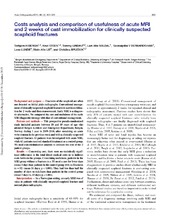Costs analysis and comparison of usefulness of acute MRI and 2 weeks of cast immobilization for clinically suspected scaphoid fractures
Bergh, Torbjørn Hiis; Steen, Knut; Lindau, Tommy; Soldal, Lars Atle; BERNARDSHAW, SOOSAIPILLAI; Lunde, Lene; Lie, Stein Atle; Brudvik, Christina
Peer reviewed, Journal article
Published version

Åpne
Permanent lenke
https://hdl.handle.net/1956/11829Utgivelsesdato
2014-11-18Metadata
Vis full innførselSamlinger
Originalversjon
https://doi.org/10.3109/17453674.2014.986627Sammendrag
Background and purpose — Fractures of the scaphoid are often not detected on initial plain radiographs. Conventional management of clinically suspected scaphoid fractures is cast immobilization for 2 weeks and then reassessment. Early MRI is a diagnostic alternative. We compared the cost and usefulness of the early MRI diagnostic strategy with that of conventional management. Patients and methods — This prospective pseudo-randomized study included patients between 18 and 49 years of age who attended Bergen Accident and Emergency Department, Bergen, Norway during 1 year in 2009–2010, after sustaining an acute wrist trauma in the previous week and with a clinically suspected scaphoid fracture. 61 patients were investigated with acute MRI, while 63 patients received standard treatment as a control group. We used cost-minimization analysis to estimate the cost of the 2 patient groups. Results — Concerning cost, there were no statistically significant differences in the total direct medical costs or in indirect costs between the groups. Concerning usefulness, patients in the MRI group without a fracture (n = 35) used a cast for fewer days (mean 1 day) than patients in the control group with no fractures (n = 52) (mean 14 days; p < 0.001). They had less than half the number of days on sick leave than patients in the control group (mean 7 days vs. 15 days; p = 0.002). Interpretation — In a Norwegian setting, an early MRI was of value in patients with clinically suspected scaphoid fracture and normal plain radiographs.
